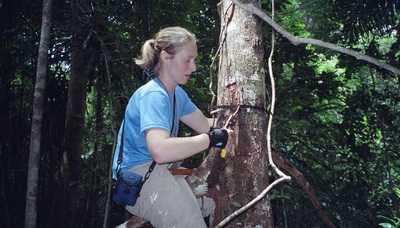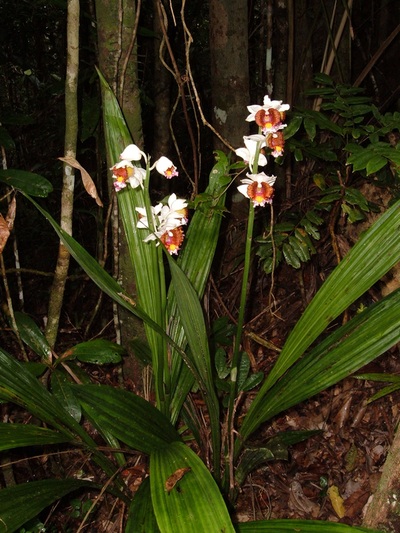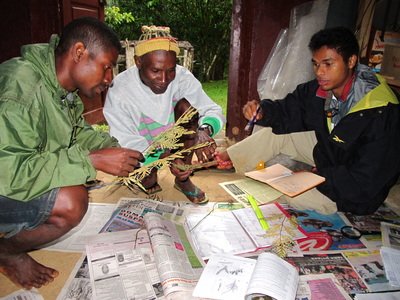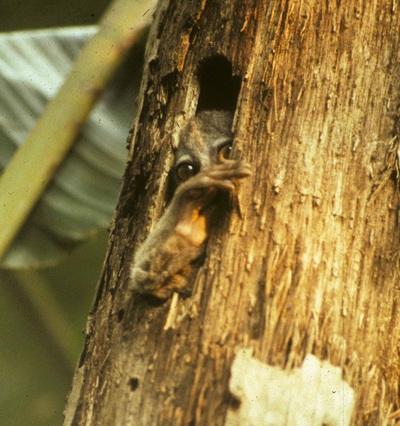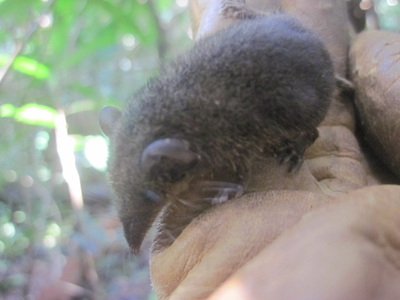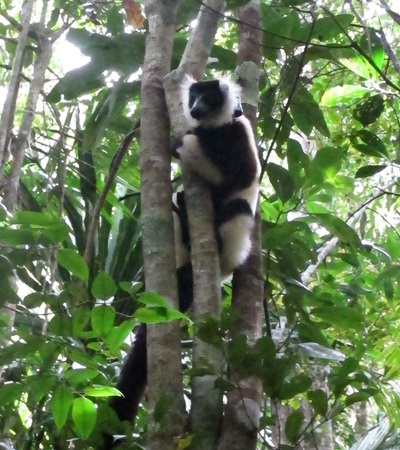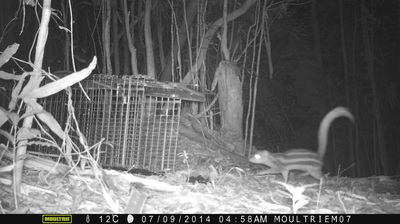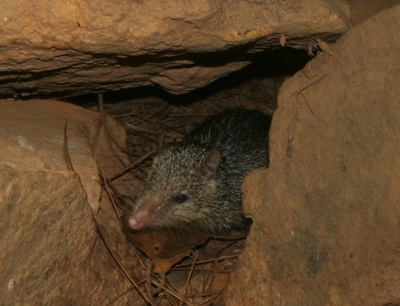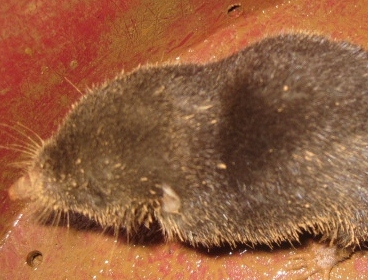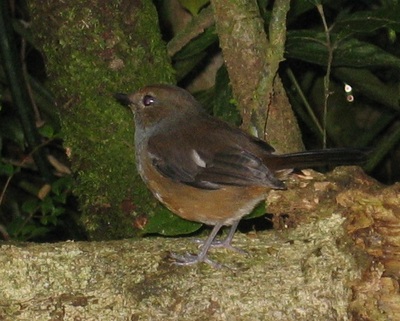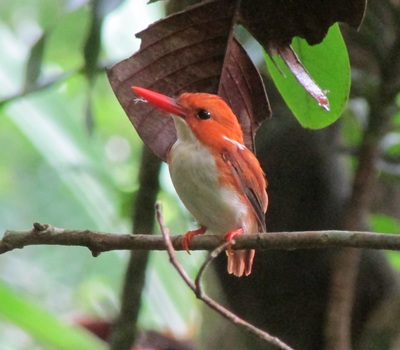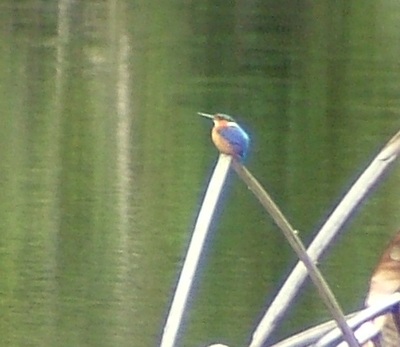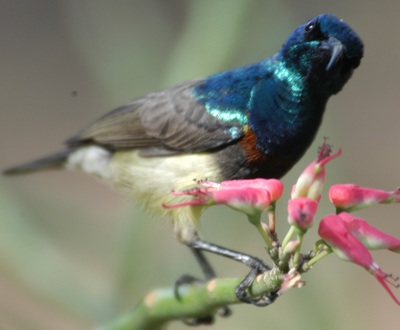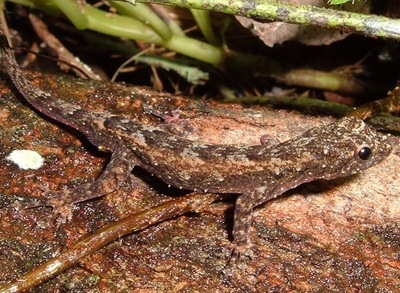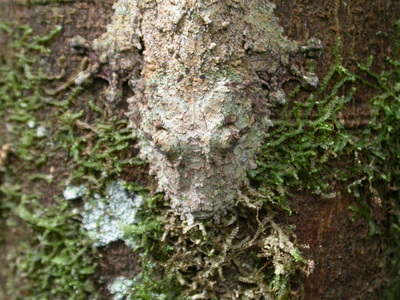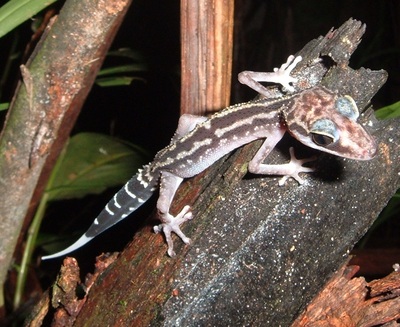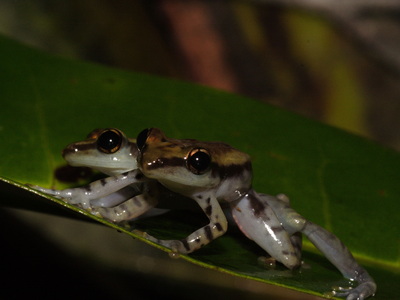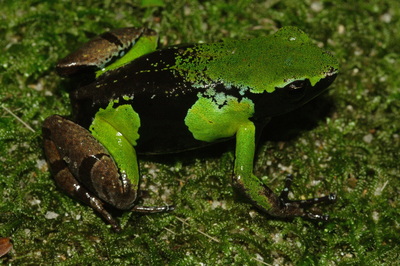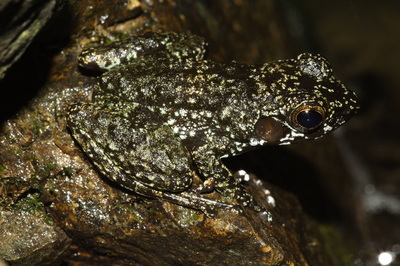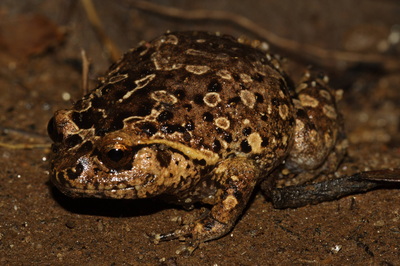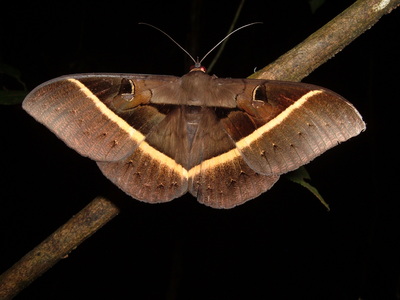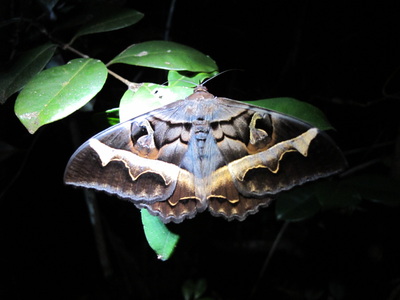Betampona Natural Reserve
Betampona Natural Reserve is a lowland rainforest located on the east coast of Madagascar 40 km northwest of Toamasina. The 2,228 hectare (5,506
acres) forest was once contiguous with the Zahamena corridor but extensive deforestation has left Betampona an isolated patch of rainforest surrounded by agriculture and degraded land. Created in 1927, Betampona was Madagascar's first protected reserve although illegal slash and burn farming did occur around and within the Reserve thereafter. Like the majority of Madagascar’s central and east coast geology, Betampona is comprised of precambrian basement metamorphic and igneous rocks.
The elevation of Betampona, previously reported as 275-650 meters, actually ranges from 92 to 571 meters with a mean of 270 meters based on calculations using NASA's high-resolution digital topographic database (Ghulam et al., 2014). The topography is characterized by steep slopes, varying between 0 - 55 degrees. The soil is red-yellow ferralitic and nutrient poor but Armstrong (2011) found that the percent of nutrient composition varied widely throughout the Reserve. With a total of 21 streams, 13 on the southern slope and eight on the northern slope, the Reserve represents an important watershed for the region.
The climate in the region is hot and humid. Based on ten years (2004-2013) of data collected by MFG’s Conservation Agents at Rendrirendry, the average annual rainfall was 3,130.4 mm; the average annual minimum and maximum temperatures were 15.2⁰C and 39.1⁰C (59.4⁰F and 102.38⁰F) with a range of 13.5⁰C and 40.5⁰C (56.3⁰F and 104.9⁰F).
acres) forest was once contiguous with the Zahamena corridor but extensive deforestation has left Betampona an isolated patch of rainforest surrounded by agriculture and degraded land. Created in 1927, Betampona was Madagascar's first protected reserve although illegal slash and burn farming did occur around and within the Reserve thereafter. Like the majority of Madagascar’s central and east coast geology, Betampona is comprised of precambrian basement metamorphic and igneous rocks.
The elevation of Betampona, previously reported as 275-650 meters, actually ranges from 92 to 571 meters with a mean of 270 meters based on calculations using NASA's high-resolution digital topographic database (Ghulam et al., 2014). The topography is characterized by steep slopes, varying between 0 - 55 degrees. The soil is red-yellow ferralitic and nutrient poor but Armstrong (2011) found that the percent of nutrient composition varied widely throughout the Reserve. With a total of 21 streams, 13 on the southern slope and eight on the northern slope, the Reserve represents an important watershed for the region.
The climate in the region is hot and humid. Based on ten years (2004-2013) of data collected by MFG’s Conservation Agents at Rendrirendry, the average annual rainfall was 3,130.4 mm; the average annual minimum and maximum temperatures were 15.2⁰C and 39.1⁰C (59.4⁰F and 102.38⁰F) with a range of 13.5⁰C and 40.5⁰C (56.3⁰F and 104.9⁰F).
Betampona is typical of other Malagasy rainforests which are characterized by a high diversity of low canopy and small girth trees as compared to rainforests in other parts of the world. Armstrong, who had worked with the MFG when a Peace Corps volunteer, returned in 2004 to carry out her PhD research in Betampona. Her specific interest was to characterize Betampona’s forest in terms of tree diversity, the similarity in species relative abundance within a community, tree height and diameter. She established 100 vegetation plots, ten meters in diameter in both primary and recovering primary forest.
Landscape features of the plots were described and trees were identified and measured in 2004 and 2005. She documented a total of 244 tree species from 49 families with Euphorbiaceae as the dominant family and, when combined with another seven of the 49 families, comprised more than 50% of the trees measured in her study plots (Armstrong et al., 2011).
Landscape features of the plots were described and trees were identified and measured in 2004 and 2005. She documented a total of 244 tree species from 49 families with Euphorbiaceae as the dominant family and, when combined with another seven of the 49 families, comprised more than 50% of the trees measured in her study plots (Armstrong et al., 2011).
Documenting overall diversity of Betampona's flora and fauna is one of the MFG's research objectives. Over the years our research team and collaborators have collected and submitted herbarium specimens to Madagascar’s national herbarium located at Parc Botanique et Zoologique de Tsimbazaza (PBZT). In 2011 the MFG engaged Dina Tahirinirainy, whose Master’s degree research was done in Betampona, to carry out an inventory of all available Betampona plant specimens in the three Tana herbarium collections at FOFIFA (Centre National de la Recherche Appliquée au Développement Rural) the National Herbarium at PBZT and the University of Antananarivo’s Department of Vegetal Ecology. The goal was to develop a comprehensive list of Betampona’s plant species that have been identified. To accomplish this required more than simply counting the number of species represented in the herbarium collections as some specimens had been misidentified when submitted and others had not been updated according to recent extensive taxonomic revisions. Upon completion, Dina found that, to date, 807 species of vascular plant from 296 genera and 114 families have been identified. Of those gymnosperms (plants whose seeds are not enclosed in an ovule) were represented by just a single family, angiosperms (mature seeds enclosed in an ovule) accounted for 93 families and pteridophytes (vascular plants that reproduce via spores) totaled 20 families. The three genera with the most species were Rubiaceae (33 genera, 117 species), Euphorbiaceae (12 genera, 23 species) and Fabaceae (11 genera, 19 species). In contrast, 63 families were represented by a single genus and 40 of those by only a single species. Categorizing the 807 species by type of plant showed that 621 were trees, 63 were shrubs, 89 were herbaceous and 34 were lianas. However, because there are areas of the Reserve that have not yet been surveyed, and herbaceous plants are very under-represented in the herbarium collections, the list is expected to grow (P. Lowry, C. Birkinshaw, pers.comm.).
Surveys of Betampona's fauna have been done for all vertebrates but only a few invertebrate groups. In numerous cases, confirmation by taxonomic experts is required for unknown or uncertain identification of species within a taxon. Betampona's mammals include six orders of native species: Carnivora with 5 species, Primates with 11 species, Chiroptera with 3 species, Rodentia with 3 species, Soricomorpha with 2 species and Afrosoricida with 3 species. Confirmation is required for several of the small mammals as well as a more comprehensive survey of the small terrestrial mammals and bats as there may be more species. Five mammalian species, all of which are invasive, are also found in Betampona: the bushpig (order Artiodactyla), black rat, Norwegian rat, house mouse and wildcat.
The MFG's bird list includes species observed inside and just outside the Reserve. In 2002 Adam Britt and the Betampona Conservation Agents produced a list of 14 orders, 39 families and 88 bird species; this list has been maintained by the Agents and now totals 14 orders, 41 families and 98 species. The MFG is looking for an ornithologist to provide input.
The reptile population was first surveyed by Chris Raxworthy, PhD, in 2004; a more comprehensive survey with a team of five herpetologists was carried out in November 2013 and the final results of this survey are pending genetic analysis. The list of species maintained by the Conservation Agents includes 8 families and 58 species with another 14 classified as unknown or identity uncertain - the 2013 survey should help to resolve the questions.
A comprehensive survey of Betampona's amphibians was done in 2007 and the results were published in 2012. The team identified 76 taxa of which 36 were candidate species. Since then four of the 36 candidate species have been named and during the reptile survey in 2013 an additional four amphibian species were found in the Reserve, increasing the number of amphibian taxa to 80.
A survey of Betampona's freshwater fish was carried out by Nick Lang assisted by two University of Toamasina students in 2006. Fish diversity is relatively low with eight species identified one of which is not a native. The only invertebrates that have been formally surveyed in Betampona are ants, butterflies/moths and snails.
Dr. Brian Fisher, Entomologist at the California Academy of Sciences, has focused his research on discovering the diversity of ants in Africa and Madagascar. He and his team have, to date, identified over 300 species in Betampona - this includes specimens that have been sorted only to morphospecies as well as those with valid names. That total includes specimens collected in 2009 by PhD candidate Dimby Raharinjanahary who was able to identify 45 new species representing 20 genera from one family - Formicidae. (Check out amazing ant photos at Dr. Fisher's AntWeb: www.antweb.org)
A four-month survey of the Reserve's snails was undertaken by Dutch Master's student Theo Linders from November 2013 to March 2014. Species identification has not been completed but Theo estimates there may be as many as 45 species. Through an initial short three-day survey in Betampona and photographs subsequently sent to him, Dr. David Lees has identified 34 Lepidoptera species, most of which are butterflies.
Dr. Brian Fisher, Entomologist at the California Academy of Sciences, has focused his research on discovering the diversity of ants in Africa and Madagascar. He and his team have, to date, identified over 300 species in Betampona - this includes specimens that have been sorted only to morphospecies as well as those with valid names. That total includes specimens collected in 2009 by PhD candidate Dimby Raharinjanahary who was able to identify 45 new species representing 20 genera from one family - Formicidae. (Check out amazing ant photos at Dr. Fisher's AntWeb: www.antweb.org)
A four-month survey of the Reserve's snails was undertaken by Dutch Master's student Theo Linders from November 2013 to March 2014. Species identification has not been completed but Theo estimates there may be as many as 45 species. Through an initial short three-day survey in Betampona and photographs subsequently sent to him, Dr. David Lees has identified 34 Lepidoptera species, most of which are butterflies.





